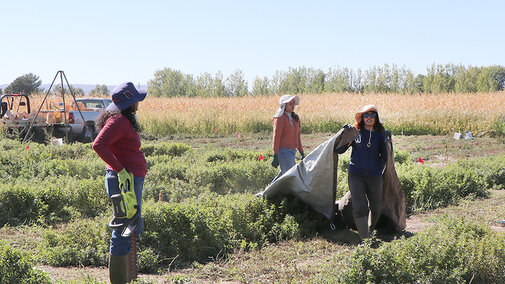Two recent projects at the University of Nebraska-Lincoln Panhandle Research Extension and Education Center in Scottsbluff involved growing peppermint and spearmint, doing it well, and saving money and greenhouse gasses.
“Way back in 2017, there was a farmer, a native of Nebraska, who had been living in Idaho and been involved in mint production. When he came back, he wanted to start growing mint,” said Dipak Santra, Nebraska Extension alternative crops breeding specialist. “He contacted me on everything mint. I had no idea, so I started doing research.”
Mint is grown for its oil, which is added to a variety of food and drink flavorings and as a fragrance in soaps and cosmetics.
Obtaining a USDA specialty crops grant, Santra began research on which peppermint and spearmint varieties would do well in western Nebraska. The two-year project in 2018 and 2019 had eight peppermint and six spearmint clones. He found peppermint grew slower and was harvested once a month in mid-August. Spearmint grew a bit faster and had two harvestings in early July and mid-September.
“I did not have a specialized lab here (Scottsbluff), so I partnered with Mahesh (Dr. Pattabiraman, University of Kearney professor of organic chemistry), who did the oil production at his lab,” Santra said.
In the two-year study, Santra found that the variety Arvensis II performed better for peppermint, with a dry mass yield of 6,544 lbs. an acre and an oil yield of 74 lbs. an acre. The spearmint variety Scotch was the top performer, with a dry mass yield of 9,332 lbs. an acre and an oil yield of 286 lbs. an acre.
“Our next question was how much nitrogen to use on the crop. I found out farmers were using up to 240 lbs. of nitrogen per acre, which is higher than what is put on corn,” Santra said.
In discussion with Bijesh Maharjan, Nebraska Extension soil and nutrient management specialist, they decided a study should be done to look at the optimal amount and what kind of nitrogen would be best for growing mint. Sujani De Silva, a graduate assistant with Maharjan, undertook the project for her master's thesis at PREEC in Scottsbluff.
“Currently, farmers in the Nebraska Panhandle use different nitrogen (N) rates and various N fertilizers in mint production, because there is no information available regarding the optimum rate and source of N fertilizer for mint production in the area,” De Silva said.
She theorized that optimized N management in mint production could increase aromatic oil yield and quality and reduce greenhouse gas emissions (nitrous oxide; N2O). Increasing N2O emissions from agriculture are linked to soil management and the application of N fertilizers.
De Silva examined urea and polymer-coated urea (PCU) to assess the effects of the fertilizer and its rates on dry matter yield and oil concentration in irrigated peppermint and spearmint. The project also assessed the effects of fertilizer N rates and sources on N2O emissions in peppermint production. The main factor was N treatment, which included the control, urea and PCU surface applied at different rates, resulting in five different soil available N levels.
In 2022, dry matter yield ranged from 3.33 to 3.98 mega-gram per hectare (Mg ha-1) in peppermint and 2.33 to 2.63 Mg ha-1 in spearmint. Only spearmint dry matter yield was significantly affected by N rates and N sources in 2022.
In 2023, dry matter yield ranged from 7.56 to 13.28 Mg ha-1 in peppermint and from 10.41 to 13.43 Mg ha-1 in spearmint.
Mint dry matter yield was greater in 2023 than in 2022, as 2022 received less N than 2023 and had plant establishment issues. In 2023, greater peppermint dry matter yield was obtained from PCU and urea at 248 kg N ha-1, while greater spearmint dry matter yield was obtained from 161 kilograms of nitrogen per hectare of soil available N with PCU, which showed the best results compared to urea.
De Silva noted oil concentrations in peppermint leaves in the fertilized treatments were greater than in the control, but they did not vary by applied N rates or sources, while spearmint oil concentrations did not show any response across N rates and sources. The urea treatments had greater N2O emissions than PCU across all N rates in both years, except for the lowest N rate in 2022. Data reported an incremental trend of N2O emission with an increment of soil available N in the urea treatments but not in the PCU in both years. N2O emission from PCU did not differ from control in both years.
“The results suggest that the N application can be optimized to improve the performance of sustainable mint production using advanced fertilizer technology such as PCU,” De Silva said. “However, more site-year data would be necessary to determine the optimum N rates.”
For more information on the study, contact Santra at Maharjan.

